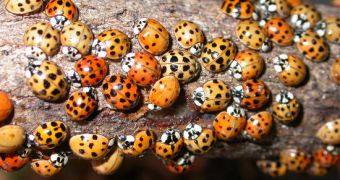Every now and then, wildlife researchers warn about the dangers linked with introducing various species in areas where they do not belong. According to a new study, these dangers hold even if the invasive species is a mere ladybird.
This research says that the Asian ladybirds (a.k.a. harlequin ladybirds) introduced in Europe and North America in order to control the aphid population are currently wreaking havoc on native ladybug species.
More precisely, it is being said that this species uses a biological weapon in order to wipe out its competition, Nature reports.
The biological weapon documented by Entomologist Andreas Vilcinskas of Justus-Liebig-University in Giessen, Germany and his fellow researchers is a parasite that causes no harm to Asian ladybirds, but which more often than not proves deadly to other such species.
“The situation is similar to when Europeans conquered the New World. The diseases they carried, such as smallpox, killed more native people than their weapons,” Andreas Vilcinskas commented with respect to the findings of this investigation.
The parasite now held responsible for the decline in Europe's and North America's native ladybug population is argued to be a single-celled organism that lives inside the body of its host, i.e. the Asian ladybird.
While living inside the harlequin ladybug's body, the parasite appears to stay in a dormant state. However, once it finds itself in other ladybugs species, it wakes up and turns into a killer.
“I have worked on insect immunity for 20 years, and I had never [before] seen a haemolymph sample that was full of microsporidians that do not harm the carrier,” said entomologist went on to argue.
By the looks of it, ladybirds do not shy away from eating each other's eggs and larvae. Specialists suspect that this is how the parasite makes its way from its host to other species.
The findings of this researcher are detailed in an article published in today's issue of the journal Science.

 14 DAY TRIAL //
14 DAY TRIAL //